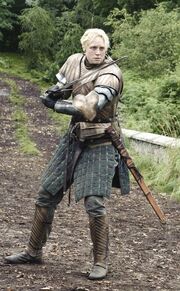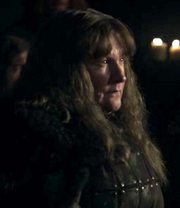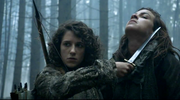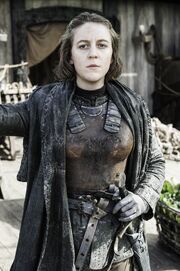 |
The title of this page is conjecture based on information revealed in the A Song of Ice and Fire novels or related material and may be subject to change.
|

Brienne of Tarth, a female warrior of noble birth.
- Arya Stark: "It wasn't just Aegon riding his dragon, it was Rhaenys and Visenya too...Rhaenys rode Meraxes, Visenya rode Vhagar...Visenya Targaryen was a great warrior. She had a Valyrian steel sword she called 'Dark Sister'."
- Tywin Lannister: "She's a heroine of yours, I take it? Aren't most girls more interested in the maidens from the songs, Jonquil, flowers in their hair?"
- Arya Stark: "Most girls are idiots."
- — Arya Stark on her admiration for warrior women.[src]
Warrior women[a] are women who are skilled in combat and take part in battle and warfare.
History[]
In the medieval world of Westeros and Essos, most warriors are men, and it is considered unusual and unfeminine for women to take up weapons and wear armor.
In Westeros, martial endeavors are considered "unladylike". While there is no formal bar against women becoming knights or skilled fighters, it is considered absurd and impossible for a woman to become skilled in fighting in any meaningful capacity, and the notion of doing so is often discouraged and mocked. Much like the Dothraki traditions, Westerosi men are a dominant social force in the Seven Kingdoms. The women often become cooks, maidservants, and general caregivers within their homes. This often meant that their roles became their sole duties. In some parts of the world, female warriors were seen as equals to the men, while at other times they are considered inferior to male knights as a general rule.

Maege Mormont, Lady of Bear Island
That being said, there are still several historical examples of women who did become great warriors. Aegon I Targaryen conquered and unified the Seven Kingdoms, but his co-commanders were his sisters Rhaenys and Visenya, who also rode dragons into battle.
There are also several subcultures within Westeros who do have a tradition of female fighters. Bear Island in the North, ruled by House Mormont, is one such example: because their economy is based on fishing but there is always the danger of imminent attack by the raiding ships of the Ironborn while the men are out at sea, the women of Bear Island are expected to be able to defend their own homes from Ironborn attacks. Thus Maege Mormont served as a soldier and commander in Robb Stark's Northern army.
A similar example can be found among the crannogmen who live in the Neck, the southernmost region of the North which borders the Riverlands. Because the crannogmen rely on guerilla tactics - retreating into the swamps then counterattacking using surprise ambushes, and using poisoned darts - both male and female crannogmen are expected to take up arms to harass invaders. Women in the hill tribes of the Vale of Arryn can also rise to be warband leaders if they are fierce enough.
An example from Essos are the Hyrkoon.

Meera Reed of the crannogmen
Dorne has a longer history of female warriors than the other Seven Kingdoms: it is still relatively uncommon there, but not quite as unusual.
Every now and then a woman from the noble courts of the Seven Kingdoms decides that she wants to pursue "unladylike" interests and tries to become a warrior or engage in tournaments - but this is considered very unusual behavior. Women such as Brienne of Tarth or Arya Stark have faced a considerable amount of discrimination for not fitting into the established gender norms of the Seven Kingdoms. For example; Brienne defies all traditions of the lady’s role. A highborn of House Tarth, she is expected to study the "women’s arts" until her father finds her a suitable husband. Brienne discovers early that her skills lie elsewhere; specifically in the fighting arts. Ned Stark relents when he realizes how enthusiastic Arya is for swordfighting, and hires Syrio Forel to train her.

Yara Greyjoy of the Ironborn.
The Iron Islands are one of the most misogynistic cultures in Westeros, but a few rare examples of warrior women can even be found there. After Balon Greyjoy's two eldest sons died in his failed rebellion , and his youngest son Theon was taken away as a ward to Winterfell, he was left with only his daughter Yara Greyjoy. Balon ultimately raised her as a surrogate son, and as she grew up Yara became a dangerous Ironborn raider, winning the respect of her men and commanding a fleet of thirty ships. Yara's example is particularly unusual, however, given how rare warrior women are among the Ironborn, even compared to the rest of Westeros.
In the forbidding lands Beyond the Wall, many of the female wildlings - known as "spear wives" are expected to take up arms alongside men to fight against the pervasive external threats in the very harsh environment. Such female warriors include Ygritte and Osha.
Notable warrior women[]
Westeros[]
- Queen {Visenya Targaryen} - Sister-wife of Aegon the Conqueror. Famously wielded Dark Sister, rode the dragon Vhagar.
- Queen {Rhaenys Targaryen} - Sister-wife of Aegon the Conqueror. Not quite the warrior that either of her siblings were, but rode the dragon Meraxes into battle. Fell to her death whilst riding Meraxes, who was shot in the eye by a Dornish scorpion.
- Arya Stark - youngest daughter of Lord Eddard Stark and Lady Catelyn Stark. Trained by Syrio Forel in the water dance, and assassination by the Faceless Men at the House of Black and White.
- Ser Brienne of Tarth - member of King Renly Baratheon's Kingsguard, later swore herself to Catelyn Stark, then to her daughter Sansa.
- Lady Yara Greyjoy - daughter of Balon Greyjoy, an accomplished raider and commander among the Ironborn, and Lady of the Iron Islands.
- Lady {Maege Mormont} - Lady of Bear Island and head of House Mormont after the exile of Jorah Mormont. Died during the War of the Five Kings.
- Meera Reed - daughter of Howland Reed. A skilled hunter and fighter among the crannogmen.
- Chella - leader the Black Ears, one of the hill tribes residing in the Vale of Arryn.
- Lady {Lyanna Mormont} - daughter of Maege Mormont and successor as ruler of Bear Island and head of House Mormont. Crushed by a wight giant during the Battle of Winterfell.
- {Obara Sand} - the first of the Sand Snakes, Prince Oberyn Martell's eight bastard daughters. Impaled by Euron Greyjoy with her own spear.
- {Nymeria Sand} - the second of the Sand Snakes. Strangled by Euron Greyjoy with her own whip.
- {Tyene Sand} - the third of the Sand Snakes, and the eldest bastard daughter between Oberyn Martell and Ellaria Sand. Poisoned by Cersei Lannister.
Beyond the Wall[]
- {Ygritte} - a spear wife and archer that fought for Mance Rayder. Shot in the back by Olly during the battle for the Wall.
- {Osha} - a spear wife that fled from the conflict beyond the Wall and became a servant of House Stark. Stabbed in the neck by Ramsay Bolton during a failed attempt to kill him.
- {Karsi} - a spear wife and wildling leader that fought for Mance Rayder. Mauled by a pack of wight children during the massacre at Hardhome.
In the books[]
In the A Song of Ice and Fire novels, several of Maege Mormont's daughters are also raised as warriors - as is the custom for women of Bear Island. Her eldest daughter Dacey Mormont becomes one of Robb's personal bodyguards. At the Red Wedding, Dacey was one of the few Northern bannermen in the main hall who managed to fight off the first wave of Frey attackers, and she was the only one who managed to reach the main door in an attempt to go for help. Unfortunately Roose Bolton and his men were waiting immediately behind the door, fully armed, and as soon as Dacey crashed into them she was killed by Ser Ryman Frey, who drove an axe into her belly.
There is a distinction between women who personally engage in combat, and women who lead armies and act as generals but do not personally fight. Such women are still considered "warriors", though not quite to the extreme of women who personally took up weapons in combat. Nor is this entirely unusual, i.e. an older man such as Tywin Lannister no longer personally engages in combat by the time of the War of the Five Kings but directs troop movements from behind.
A thousand years ago the warrior-queen of the Rhoynar, Nymeria, led her surviving people to Dorne as they fled the advance of the Valyrian Freehold. Arya Stark admired Nymeria so much that she named her direwolf after her. George R.R. Martin later explained that while Nymeria was considered a "warrior-queen" she was more of a general, who led armies but did not personally fight.
The World of Ice & Fire and Fire & Blood reveal more warrior women throughout the histories of Westeros, Essos, and beyond. Xanda Qo and her daughter Chatana Qo were both skilled archers from Summer Isles who briefly united the isles as a political entity. Wylla of Wyl was a shield-maiden in ancient Dorne; Lady Agnes Blackwood fought against the ironborn invasion of the Riverlands, and Lady Sabitha Frey and Alysanne Blackwood fought in the Dance of the Dragons. Targaryen women sometimes had female sworn shields throughout history, such as Jonquil Darke, the sworn shield to Queen Alysanne Targaryen, or Melony Piper, a lady companion of Princess Rhaena Targaryen who died fighting in the Battle Beneath the Gods Eye.
Just because certain women do not personally engage in combat doesn't mean they don't exert massive influence on politics and warfare, given that warfare is an extension of politics. For example, Olenna Tyrell - the matriarch of House Tyrell - is certainly no "warrior" in the sense that she does not wield physical weapons. Yet "the pen is mightier than the sword", and Lady Olenna's political decisions have sent thousands of men into battle. Similarly, Catelyn Stark is not a "warrior" or particularly a commanding general on the battlefield, but her political decisions still direct the course of entire wars.
As George R.R. Martin has said:
- "I wanted to present my female characters in great diversity, even in a society as sexist and patriarchal as the Seven Kingdoms of Westeros. Women would find different roles and different personalities, so women with different talents would find ways to work with it in a society according to who they are."[1]
References[]
Notes[]
- ↑ Conjecture based on information from The World of Ice & Fire; may be subject to change.
